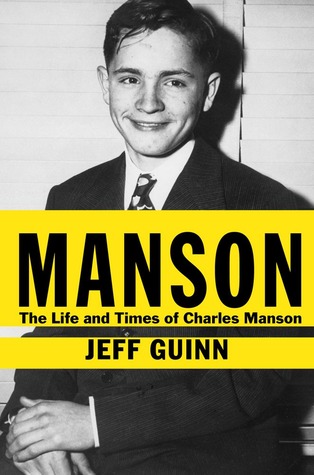Manson: The Life and Times of Charles Manson by Jeff Guinn
(Simon & Schuster; 512 pages; $27.50).
 Prior to the publication of Jeff Guinn’s book Manson: The Life and Times of Charles Manson, Vincent Bugliosi’s national bestseller Helter Skelter was the definitive volume on Manson, his followers, and the series of murders his minions committed (the most famous of which was actress Sharon Tate) in August 1969. Guinn has written a fascinating and essential biography of the cult leader and notorious killer. To understand Manson and his era, Guinn’s take on the 78-year-old infamous murderer is not only important but necessary.
Prior to the publication of Jeff Guinn’s book Manson: The Life and Times of Charles Manson, Vincent Bugliosi’s national bestseller Helter Skelter was the definitive volume on Manson, his followers, and the series of murders his minions committed (the most famous of which was actress Sharon Tate) in August 1969. Guinn has written a fascinating and essential biography of the cult leader and notorious killer. To understand Manson and his era, Guinn’s take on the 78-year-old infamous murderer is not only important but necessary.
Charles Manson was pure evil personified. Guinn writes, “There was nothing mystical or heroic about Charlie—he was an opportunistic sociopath.” Guinn begins by effectively charting Manson’s history of incarceration. Both Manson’s mother and his uncle were imprisoned, and their tendency to commit crimes seems to have been passed down to Charlie. Interestingly, Manson spent more time in jail than he did out of it.
It was in prison where Charlie first read Dale Carnegie’s self-help book How To Win Friends and Influence People. This was the one instance in which Manson himself was a convert. Guinn shines as he takes Manson to San Francisco in the late 1960s, where he used Carnegie’s methods on young girls who were down on their luck and desperately searching for something. Or someone.
Manson convinced the young women that they were all looking for him; he knew just how to manipulate them. Using sex and drugs, Manson eliminated their super egos and eradicated all their barriers. This insured they would do anything he asked of them. Although he had trouble reading, Guinn suggests that Manson was especially savvy and intelligent, especially when it came to influencing people.
Since Los Angeles was the center of everything in the 1960s, particularly music, Manson and his cohorts settled there. It was not long before they were hanging out with Beach Boy Dennis Wilson and even Neil Young. In fact, Gregg Jakobson, talent scout, session arranger, and good friend of Wilson’s, first used the term “the Family” to describe Manson and his followers. The name stuck.
Manson hoped to get a recording contract but producers, like Doris Day’s son Terry Melcher, passed. However, Manson and his devotees still managed to spend around $100,00 of Wilson’s money and also obtained funds from Didi Lansbury, daughter of actress Angela Lansbury. Eerily, Manson sent his people off on “creepy crawls,” where they would break into a house at night and, while the owners slept, rearrange their belongings. Manson ordered his disciples not to steal anything, and they obeyed him. Only when the unsuspecting home owners awoke would they realize their homes had been violated. On one such creepy crawl, Manson’s acolytes broke into the home of John and Michelle Phillips of the musical group The Mamas and the Papas.
Guinn convincingly places Manson within his historical era. The author writes, “The unsettling 1960s didn’t create Charlie, but they made it possible for him to bloom in full, malignant flower.” The atmosphere of the late 60s was perfect for someone like Charlie, and he took full advantage of the tumult, even instilling fears of a race war, “Helter Skelter,” into his followers.
When Manson’s hopes for a career in music were dashed, he feared he would become lessened in the eyes of his supporters. For a cult leader, this was unthinkable. He had to act. He had to somehow bind them to him forevermore. He had to make them kill for him, Guinn maintains. And they, good little soldiers that they were, did exactly that.
A significant portion of Manson is devoted to August of 1969 and the gruesome Tate and LaBianca murders and the subsequent trial in which Bugliosi served as chief prosecutor. I have read Helter Skelter eight to ten times, yet so much of what Guinn wrote was new to me. He interviewed many of those involved, some of whom had never spoken to any other writer before. Guinn’s never-before-revealed information kept a decades-old crime intriguing, fresh, and compelling.
Manson belongs right next to Helter Skelter. The two books of true crime complement each other nicely and should be read together for maximum effect. They are two very different books. The emphasis in Helter Skelter was on the trial and its preparation. Bugliosi provided sketches of most of the people involved from the victims to the perpetrators to those knowledgeable. While Manson was an important part of Helter Skelter, he was not the primary focus. Guinn’s chilling and informative book, in contrast, is all about Manson. You may think you know the story, but Guinn’s new material will have you glued to the page.



